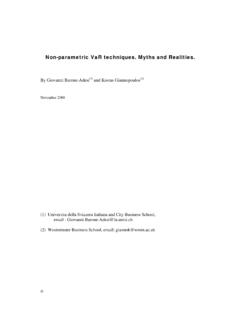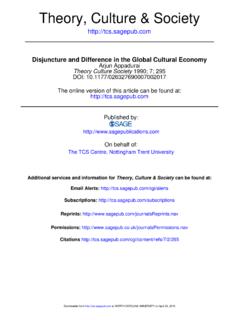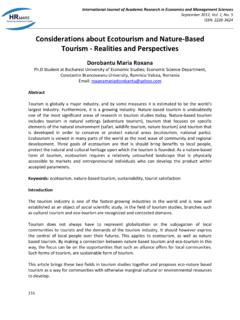Transcription of CENTER FOR STRATEGIC AND INTERNATIONAL …
1 The Cyber Index is intended to serve as a snapshot of current cyber-security activities at the national, regional, and INTERNATIONAL levels, to helppolicymakers and diplomats understand the complexity of the arena. Inaddition, the Index seeks to elucidate some approaches towards mitigatingthe risks of misperceptions in the cyber domain that threaten to elevateinternational tensions or perhaps even lead to conflict. The subject matteris multifaceted, highly complicated, and controversial thus no one studycould adequately cover all aspects in depth. Nonetheless, the Cyber Indexwill help to underpin ongoing discussions and debates by providing factsand fact-based analysis of today s challenges and opportunities regardinginternational stability and security in the cyber and printed by the Publishing Service, United Nations, May 2013 1,950 UNIDIR/2013/3 UNIDIR UNIDIR TThe Cyber Indehe Cyber Index x INTERNATIONAL Security INTERNATIONAL Security TTrrends and Realitiesends and RealitiesUNITED NATIONSThe Cyber IndexInternational Security Trends and RealitiesUNITEDNATIONSINSTITUTEFORDISARM AMENTRESEARCHCENTER FORSTRATEGIC ANDINTERNATIONALSTUDIESINSTITUTE FORPEACE RESEARCHAND SECURITYPOLICYUNIDIR/2013/3 The Cyber IndexInternational Security Trends and RealitiesUNIDIRU nited Nations Institute for Disarmament ResearchGeneva, SwitzerlandNew York and Geneva.
2 2013 NOTEThe designations employed and the presentation of the material in this publication do not imply the expression of any opinion whatsoever on the part of the Secretariat of the United Nations concerning the legal status of any country, territory, city or area, or of its authorities, or concerning the delimitation of its frontiers or boundaries.** *The views expressed in this publication are the sole responsibility of the individual authors. They do not necessarily reflect the views or opinions of the United Nations, UNIDIR, its staff members or United Nations, 2013 All rights reservedUNITED NATIONS PUBLICATIONSThe United Nations Institute for Disarmament Research (UNIDIR) an autonomous institute within the United Nations conducts research on disarmament and security. UNIDIR is based in Geneva, Switzerland, the centre for bilateral and multilateral disarmament and non-proliferation negotiations, and home of the Conference on Disarmament.
3 The Institute explores current issues pertaining to the variety of existing and future armaments, as well as global diplomacy and local tensions and conflicts. Working with researchers, diplomats, government officials, NGOs and other institutions since 1980, UNIDIR acts as a bridge between the research community and governments. UNIDIR s activities are funded by contributions from governments and donor .. viiAbout the authors .. viiiForeword .. ixIntroduction .. 1 PART I Chapter 1: Cybersecurity and cyberwarfare:assessment of national doctrine and organizationJames Andrew Lewis .. 9 States with military doctrine, policies, or organizations .. 9 States with civilian policies and organizationsfor cybersecurity .. 55 Chapter 2: Assessment of INTERNATIONAL andregional organizations and activitiesG tz Neuneck .. 91 Role of INTERNATIONAL organizations .. 93 United Nations .. 93 INTERNATIONAL Telecommunication Union.
4 96 Internet governance organizations .. 97 Convention on Cybercrime .. 98 Group of Eight .. 99 Key INTERNATIONAL conferences .. 100 Regional organizations .. 101 Organization of American States .. 101 Organization for Security Co-operation in Europe .. 102 European Union .. 103viShanghai Cooperation Organization .. 105 ASEAN Regional Forum .. 106 North Atlantic Treaty Organization .. 107 PART II Transparency and confidence-building measures: applicability to the cybersphere?G tz Neuneck .. 113 Chapter 1: Civilian and military cyberthreats:shifting identities and attributionG tz Neuneck .. 115 States as actors: preparing for cyberwar? .. 116 Chapter 2: Types of confidence-building measuresG tz Neuneck .. 121 Classical confidence-building in the military andnon-military domains .. 122 Confidence- and security-building measures .. 125 Confidence- and security-building categories in Europe.
5 126 Confidence- and security-building categoriesoutside Europe .. 128 Non-military CBMs A wider approach .. 129 Transparency and confidence-building for cyber andouter space activities .. 130 Chapter 3: Towards TCBMs in the cybersphereG tz Neuneck .. 133 Conclusion .. 138 Abbreviations .. 139viiACKNOWLEDGMENTST hanks to Kerstin Pertermann who helped to collect, structure, and prepare the text on INTERNATIONAL organizatons and from UNIDIR s core funders provides the foundation for all of the Institute s addition, dedicated project funding was received from the Government of THE AUTHORSJ ames Andrew Lewis is a senior fellow and Program Director at the CENTER for STRATEGIC and INTERNATIONAL Studies. Before joining the CENTER , he worked at the US Departments of State and Commerce as a Foreign Service Officer and as a member of the Senior Executive Service. He was the Rapporteur for the 2010 United Nations Group of Governmental Experts on Information Security.
6 Lewis s recent work has focused on cybersecurity, including the ground breaking Cybersecurity for the 44th presidency . Recent reports include Thresholds for cyber warfare , Deterrence and credible threats , Internet governance and cybersecurity , Multilateral agreement to constrain cyber conflict , and Privacy and cybersecurity . His current research examines STRATEGIC competition and technological innovation. Lewis received his PhD from the University of tz Neuneck is Deputy Director of the Institute for Peace Research and Security Policy at the University of Hamburg. Trained as a physicists at the University of D sseldorf, he received his PhD in mathematics at the University of Hamburg, and since 2007 is a professor at the Faculty of Mathematics, Informatics, and Natural Sciences at the University of Hamburg. Since 2001 Neuneck is speaker of the Physics and Disarmament Working Group of the German Physical Society and a member of the Council of the Pugwash Conferences on Science and World Affairs.
7 His current areas of work are nuclear arms control and disarmament, ballistic missile defence, space/cybersecurity, and non-proliferation of military , cyberspace is part of the daily life of many citizens, communities, industry, academia, and governments around the world. Moreover, the global expansion of digital media, networks, and information and communications technologies (ICTs) might well become the most powerful technological revolution in the history of humankind. Social media, internet shopping, and online banking are becoming ever more popular, creating a powerful economy while enabling borderless exchange of information and media. In 1993, only 50 Internet websites existed; this number increased to 555 million in 2011 and will continue to grow. The Internet facilitates free speech and the exchange of information, the propagation of the use of modern technologies, and free early development of the Internet was very much determined by insider communities of technologists and private sector actors.
8 Due to the rapid pace of technological development, the increase in use of ICTs, and the rapid expansion of internet access, many political, legal, and societal aspects of the cybersphere are not yet fully understood. But it is clear that multilateral debate must focus not only on future cyber threats and acceptable responses, but also on individual and state rights in the cyber domain, the question of future internet governance, and the role of civil society, governments, and the military in securing the benefits to states, communities, and individuals of the cybersphere are clear. The Information Revolution has given the global community the capability to rapidly and easily connect individuals, companies, governments, INTERNATIONAL institutions, and other entities. Interconnectivity via digital networks is the key characteristic of today s global economy, and is increasingly required for global economic stability and , these benefits come with risks and costs.
9 Civil society, the private sector, governments, and militaries are increasingly dependent on networked ICTs, which creates new vulnerabilities to national and global security. Indeed, we have seen steady annual growth in cybercrime and other types of malfeasance in the cybersphere in tandem with the expansion of use. According to internet security firm Symantec, web-based attacks increased in 2011 by 36 per cent over 2010, with more than 4,500 xnew attacks each day. Some 403 million new variants of malware were created in 2011, a 41 per cent increase over Cyberattacks are often defined broadly as the unauthorized penetration of computers or digital networks. Cyberattacks are occurring every day, ranging from website defacement, to denial-of-service attacks, to the theft of data and infiltration of computers and servers. Based on malware or corrupted programs, these activities range from manipulating passwords, to stealing data, to hijacking computers for a variety of illegal purposes (through tools such as botnets), to disrupting services.
10 Cyberattacks are intended to prevent users from access to services or to disrupt computer-controlled machines, while cyber exploitation is conducted to penetrate computers to obtain Most of these attacks do not cause physical damage, but instead often result in economic loss and sometimes to increasing tensions among states. Cyberattacks worldwide are becoming more complex and frequent, and the economic damage caused is increasing. Government efforts to protect infrastructure and undertake law enforcement in the cybersphere are complicated by the fact that most infrastructure and assets involved are owned and operated by private sector actors, who have widely diverse motivations and sometimes competing equities to protect. For example, efforts by the Obama administration to pass cybersecurity legislation have been battered by corporate interests seeking to avoid new regulatory burdens on one hand and, on the other hand, the concerns of many civil liberties organizations about protecting the privacy of citizens online.








